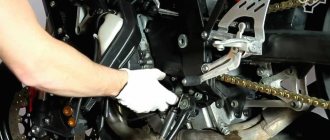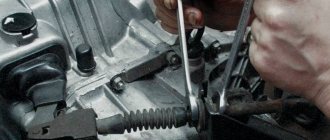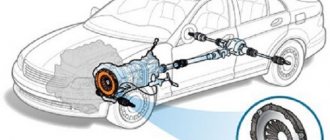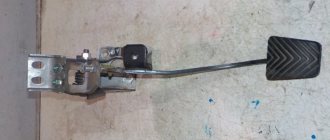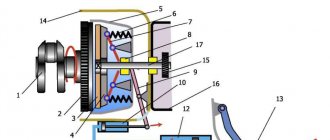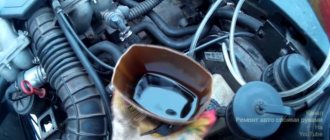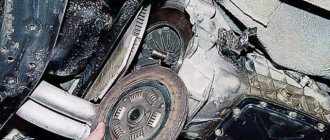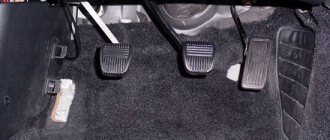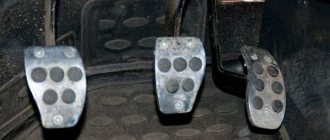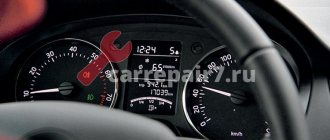The design of a car with a manual transmission necessarily requires the presence of a clutch mechanism in the transmission device. At the same time, it should be noted the importance of this unit, since it is thanks to the clutch that torque is transmitted from the engine to the wheels, and it is also possible to move away softly and smoothly and then change gearbox gears.
Simply put, the clutch connects the gearbox and the engine, allowing the force of the internal combustion engine to be transmitted to the transmission. Moreover, if such a need arises, the clutch allows you to “unloose” the rigid connection between the internal combustion engine and the gearbox. In this article we will take a detailed look at what a clutch is for and how a car’s clutch works, as well as what to pay attention to when operating a car with a manual transmission.
Why do you need a clutch?
All types of internal combustion engines produce torque within a limited speed range. To change the speed of rotation of the drive wheels, the internal combustion engine must be additionally equipped with a transmission. It allows the engine to operate in the optimal speed range, while changing the rotation speed by changing gears.
But changing gear is a technically complex process, since it requires a temporary interruption in the supply of torque from the engine to the transmission. But then, in order to smoothly change speed, you will need to turn off the engine. The purpose of the clutch is to interrupt the communication between the gearbox and the engine when it is running. That is, this unit stops transmitting torque from the engine to the gearbox when the engine is continuously running.
Classification [edit | edit code ]
- According to the control method - clutches with a mechanical, hydraulic, electric or combined drive (for example, hydromechanical).
- By type of friction - dry (friction linings work in air) and wet (work in an oil bath).
- According to the switching mode - permanently closed and non-permanently closed.
- According to the number of slave disks - single-, double- and multi-disk.
- According to the type and arrangement of pressure springs - with the arrangement of several cylindrical springs along the periphery of the pressure disk and with a central diaphragm spring.
- According to the number of torque transmission streams - single and double stream.
Design and principle of operation of the clutch
The main part of the clutch is a disc, which is coated on both sides with friction material with a high coefficient of friction. It is mounted on the flywheel, and when an external force is applied to the disk, it rotates along with the flywheel.
The transmission drive shaft is connected to the clutch disc, through which torque is transmitted to the gearbox. The clutch drive, consisting of a basket, pressure plate and casing, creates this external pressing force. In this case, the casing with which the clutch basket is mounted must be firmly attached to the flywheel, pressing the pressure plate against the clutch disc. In this position, the torque from the engine is completely transmitted to the gearbox.
To open the clutch mechanism, or clutch as it is also called, and stop the supply of torque to the transmission, a special diaphragm spring is used. Its outline always remains motionless, and the petals in the middle are pursed. It is located between the pressure plate and the casing. If you press the inner part of the spring, it will move the clutch disc away from the main disc. Accordingly, the torque supply will be suspended. This process occurs when the driver presses the clutch pedal. At the moment when the mechanical clutch circuit is open, you can change gear. After the switching has taken place, the pedal is released, the clutch operation resumes and the torque is again transmitted to the transmission.
The clutch disc contains several damper springs designed to level out the oscillations and vibrations they generate, the source of which is the running engine. In this case, the design of the clutch driven disc is such that its hub is not rigidly attached to the main disc. That is, the torque is transmitted to the clutch disc, then to the springs, and only after that to the driven disc hub. In this way, the torsional vibrations created by the engine are almost completely damped, providing greater smoothness.
When you press the clutch pedal, the force is transmitted through the master and slave cylinders, after which a special fork disconnects the disc and the flywheel. The master and slave cylinders of the clutch consist of a housing in which the pusher and piston are located; they are filled with fluid, which in its properties resembles brake fluid. When you press the pedal, fluid under pressure enters the main cylinder, which transmits pressure to the working cylinder, where it acts on the fork, the spreading clutch. After releasing the pedal, the fluid returns through the valve to the main cylinder, and the disk is connected to the flywheel. This system allows you to reduce the force applied to the pedal due to the difference in the volume of the cylinders.
Brief historical background
While working on the creation of the first cars, engineers discovered the need for a device that would transmit torque from the engine to the wheels, but with different amplitudes of rotation, so that the car would move smoothly.
Without such a device, every time you wanted to slow down or increase the speed, you would have to completely turn off the engine. And this device was invented by the German engineer Karl Benz in 1885. The clutch then consisted of two pulleys connected by a leather belt. The driver moved the pulleys apart with a lever, which made it possible to open and close the clutch. The next stage in improving the device was the invention of the cone clutch by German engineers Gottlieb Daimler and Wilhelm Maybach in 1889. In the cone clutch design, the leather belt is replaced by a spring. This design was replaced by another - a multi-disc one, which worked in a liquid medium (kerosene or oil). Then Ferodo linings began to be put on the discs, and the automotive industry switched to dry single-plate clutches. The prototype of the modern diaphragm clutch was developed by auto mechanics of the American corporation General Motors in 1936, but due to the war, their mass production began only in 1965 and continues today.
Proper clutch operation
Commands to move the clutch disc and flywheel in and out are given by the driver by pressing the corresponding pedal, which is located under the left foot. The principle of operation of the clutch pedal is that it moves the disc away from the flywheel through a mechanical drive system. When it is released, the disk again comes into contact with the flywheel, transmitting torque to the transmission.
A complex mechanical unit, the gearbox, is attached to the input shaft of the transmission. It also cannot work without a clutch, since making shifts without temporarily disconnecting it from the engine is very difficult, and for beginners this task is generally impossible to solve.
Torque is transmitted to the gears of the input shaft, which stops when the clutch pedal is pressed. In the neutral position of the transmission, this does not matter, since even with the input shaft moving, it does not engage the output shaft.
To transfer torque to the output shaft, the driver depresses the clutch to stop the input shaft. Then he uses a lever to select the desired gear, connecting the gears of the shafts; after releasing the pedal, the torque is transferred from the primary shaft to the secondary one.
When driving a car, you need to know some points that will allow you to avoid common mistakes:
- The design and operation of the clutch, when you press the pedal, leads to the fact that the torque is no longer transmitted to the drive wheels and the car, after driving for some time, will stop by inertia, but the engine will run and never stall.
- If the gearbox is in neutral, the car will not move and the engine will not stall.
The clutch pedal has three conditional positions in which the main phases of the system’s operation occur:
- top position when the pedal is not pressed;
- middle or working position. On different cars this position may be higher or lower from the floor, so when transferring to a new car you need to find it;
- bottom position with the pedal fully depressed.
It is in the middle position that the disk comes into contact with the flywheel; in order to avoid excessive wear of the parts, they must be connected very smoothly. The main mistake of beginners who know that the clutch needs to be released gradually: after reaching the engagement of the disc and the flywheel, they suddenly drop the pedal, the car jerks several times and stalls.
To get going correctly, you need to depress the clutch pedal, engage first gear, quickly release the pedal to the middle position and the pedal is held there for about three seconds. After the car has driven about one meter, the pedal is completely released.
When changing to a higher gear, the clutch must be released quickly, and the higher the gear, the faster the pedal is released. All these skills are achieved gradually through repeated training.
Video: How does the clutch work?
Starting a car on a hill
Many novice drivers experience serious difficulties when starting a car on an incline. But, knowing the principle of operation of the manual transmission clutch and the sequence of actions, they will do it much more confidently. This sequence of actions can be used when the handbrake in the car does not work well:
- the clutch and brake pedals are initially depressed with the engine idling;
- the clutch pedal is slowly and smoothly released until the engagement of the clutch disc and transmission is felt, at which point the car begins to tremble;
- the foot is removed from the brake pedal, but the car will not roll backwards, since the clutch acts as a brake;
- the gas pedal is pressed and the car begins to roll forward.
How the car clutch works
The principle of operation of a car clutch is to smoothly connect and disconnect two metal discs: one is rigidly attached to the engine shaft, and the second to the gearbox.
The clutch mechanism is activated by a cable leading from the pedal into the engine compartment of the car directly to the clutch mechanism itself. When the pedal is pressed, the engine and transmission are disconnected.
The main parts of the clutch mechanism are:
- Crankshaft flywheel;
- Drive disk (pressure);
- Driven disk.
The disk that transmits the engine force is called the drive disk (also known as the clutch disk or “basket”). It is hinged to a stamped steel casing, which in turn is rigidly bolted to the crankshaft flywheel. This type of fastening allows the clutch drive disc to change the distance to the housing.
When moving longitudinally, the clutch “basket” presses a disk called the driven . It is connected to the input shaft of the gearbox. In the working position, the driven disk is fixed between the flywheel and the pressure plate, and when the clutch pedal is pressed, it is released.
Smooth engagement of the clutch is ensured by the discs sliding until they are completely pressed against each other. To do this, the driven disk is made of several parts separated by elastic plates. It also has special linings made of material that is resistant to heat and wear. The clutch pressure plate is also spring-loaded and has heat-insulating gaskets.
When the clutch pedal is released, the driving and driven discs are pressed against the flywheel by strong springs, forming a rigid structure. In this case, the gearbox shaft begins to rotate at the same speed as the crankshaft, transmitting force to the transmission units and then through the drive shafts to the wheels. The car starts moving.
General information [ edit | edit code]
There are many different types of clutch, but most rely on one or more friction discs pressed tightly together or onto the flywheel by springs. The friction material is very similar to that used in brake pads and previously almost always contained asbestos; more recently, non-asbestos materials have been used. Smooth engagement and disengagement of the gear is ensured by the sliding of the constantly rotating drive disk attached to the engine crankshaft relative to the driven disk connected through a spline to the gearbox.
Operating principle of clutch actuators
The principle of operation of the car's clutch drive, with which the force from the pedal is transmitted to the shift mechanism, can be mechanical, hydraulic or electric.
The mechanical clutch drive is structurally the simplest: it consists of a steel cable connecting the pedal rod and the clutch lever. There is usually a threaded connection on it, which can be used to adjust the length of the cable. The disadvantage of this drive is that it requires more force when pressing the pedal.
The hydraulic drive is more comfortable to use, especially if you have to use the clutch frequently. Its operating principle is similar to the operation of the brake system: when you press the pedal, the piston presses on the fluid, which, moving in the cylinder, sets the clutch lever pusher in motion. In this case, the pedal stroke is softer, but you need to monitor the condition of the hydraulic hoses and control the level and quality of the hydraulic fluid poured into the system.
The electric drive differs from the mechanical one in that the clutch release cable is driven by an electric motor, which is activated when the pedal is pressed. Otherwise, its design is not much different from a mechanical drive.
conclusions
So, in this article we introduced you to the principle of operation of the clutch and explained what functions it performs in the design of the car. Like any part, the clutch tends to wear out. It is impossible to determine the exact shelf life of this mechanism, since it directly depends on the dexterity and accuracy of the driver. Grip also suffers from uneven road surfaces with deep holes and from traffic jams, since the driver often has to slow down, or even brake completely, and then move off again. Therefore, if you hear an unpleasant smell in the cabin, there is a reason to stop by the service station and have a technical inspection.
How to use the clutch on a car correctly
In practice, working with a car’s clutch is mainly expressed in developing the skill of properly starting off, especially on an uphill slope. In busy city traffic, skillful use of the pedal will allow the car to move smoothly and not stall during sudden braking.
When starting to move, you need to release the clutch pedal, catch the moment of contact of the discs, balance the speed of their rotation, and then smoothly release the pedal. The reference point is the engine speed. If the engine runs smoothly, the clutch engages correctly.
The clutch should only be used when starting, changing gears and when stopping the vehicle. Compliance with this requirement will extend its service life.
- A sharp or, conversely, slow release of the clutch pedal at start leads to accelerated wear of the working surface of the discs.
- Stopping at a traffic light with the pedal pressed and the gear engaged will not have the best effect on the operation of the pressure springs, bearing and release fork.
The two main malfunctions of the clutch mechanism are insufficiently tight contact of the discs and insufficiently complete separation of them.
- In the first case, the clutch slips, and the car will experience poor acceleration dynamics. This is usually the result of wear on the driven disk and its friction linings.
- In the second case, as a result of incomplete separation of the disks when the gear is engaged and the pedal is pressed, the car tries to move.
If these malfunctions cannot be eliminated by adjusting the drive, then repair of the mechanism itself is necessary under stationary conditions.
How does the clutch work in robotic gearboxes?
Automatic (robot) transmissions also have a multi-plate “wet” clutch or are equipped with a “dry” clutch. Moreover, in this case, it is not the driver who presses the pedal who is responsible for turning the clutch on and off, but the servomechanism (clutch actuator).
Gear shifting on a manual transmission is also carried out using similar mechanisms. Actuators can be electric (controlled by an ECU) or hydraulic (controlled by a hydraulic distributor). In this case, as mentioned above, both an electric drive and a hydraulic drive (hydraulic clutch actuator) can be responsible for squeezing the clutch.
In the first case, the gearbox ECU, based on the readings of several sensors, determines the moment of gear shifting and sends a control signal to the clutch actuator (servo). The electric motor starts to work, disconnecting the gearbox from the internal combustion engine. Then the automation switches on the desired gear.
The hydraulic drive works in such a way that when the engine speed increases, the oil pump in the box pressurizes oil into the distributor. When the oil pressure in the distributor reaches a certain point, the oil is supplied through special oil channels and acts on the actuator.
We also recommend reading the article on how to replace the clutch on a DSG. From this article you will learn about the features of replacing a DSG clutch, as well as what needs to be taken into account as part of such a replacement.
As a result, the mechanism responsible for disengaging the clutch is activated. Then, after changing gear, the pressure is reduced, the clutch “connects” the engine to the transmission again.
At the same time, the “robot” does not always work quickly and smoothly. As a result, the driver notices a pause, and jerks and jolts may also be felt during shifts. To get rid of such shortcomings, the designers proposed a double clutch for the robot box.
In preselective dual-clutch robots (DSG type), these clutches operate alternately. When the first clutch is depressed to engage an even gear, for example, the second clutch waits to be depressed to shift to the next odd gear.
The advantages include the fact that the clutch response speed is much higher, gear shifting occurs unnoticed by the driver. The result is increased fuel efficiency, virtually no interruption in power flow at the time of switching, as well as a high level of comfort.

